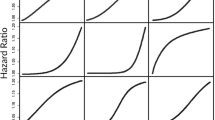Abstract.
A panel of 277 children, aged 3–7 years, was used to study the association between air pollution (O3, SO2, NO2, and total suspended particles), meteorological factors (global radiation, maximum daytime temperature, daily averages of vapour pressure and air humidity) and respiratory symptoms. For 759 days the symptoms were recorded in a diary and modelling was based on a modification of the method proposed by Korn and Whittemore (Biometrics 35: 795–798, 1979). This approach (1) comprises an extension using environmental parameters at different time scales, (2) addresses the suitability of using the daily fraction of symptomatic individuals to account for inter-individual interactions and (3) enables the most significant weather effects to be identified. The resulting model consisted of (1) an individual specific intercept that takes account of the population's heterogeneity, (2) the individual's health status the day before, (3) a long-term meteorological effect, which may be either the squared temperature or global radiation in interaction with temperature, (4) the short-term effect of sulfur dioxide, and (5) the short-term effect of an 8-h ozone concentration above 60 µg/m3. Using the estimated parameters as input to a simulation study, we checked the quality of the model and demonstrate that the annual cycle of the prevalence of respiratory symptoms is associated to atmospheric covariates. Individuals suffering from allergy have been identified as a group of a particular susceptibility to ozone. The duration of respiratory symptoms appears to be free of scale and follows an exponential distribution function, which confirms that the symptom record of each individual follows a Poisson point-process. This supports the assumption that not only respiratory diseases, but also respiratory symptoms can be considered an independent measure for the health status of a population sample. Since a point process is described by only one parameter (namely the intensity of the point process), it is appropriate for records of respiratory symptoms to identify only one model which covers both the occurrence and duration of symptoms.
Similar content being viewed by others
Author information
Authors and Affiliations
Additional information
Electronic Publication
Rights and permissions
About this article
Cite this article
Schlink, U., Fritz, G.J., Herbarth, O. et al. Longitudinal modelling of respiratory symptoms in children. Int J Biometeorol 47, 35–48 (2002). https://doi.org/10.1007/s00484-002-0142-2
Received:
Accepted:
Issue Date:
DOI: https://doi.org/10.1007/s00484-002-0142-2




